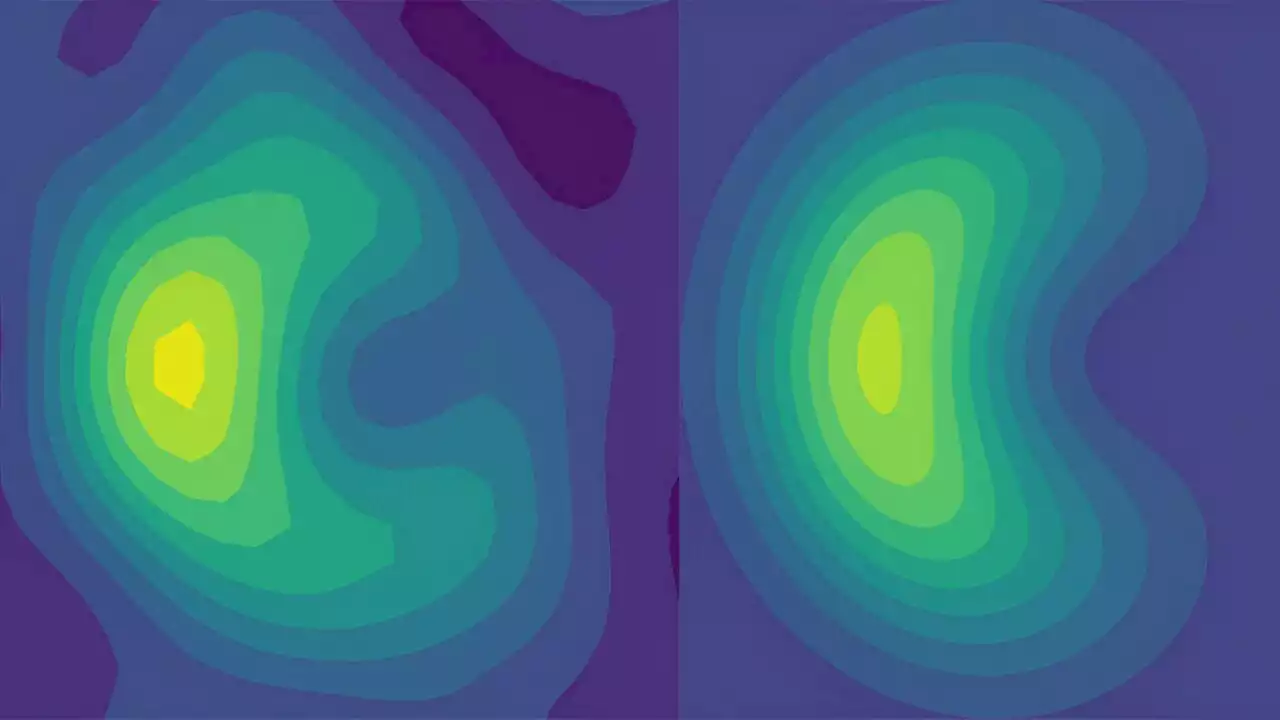Researchers have implemented a quantum-based method to observe a quantum effect in the way light-absorbing molecules interact with incoming photons. Known as a conical intersection, the effect puts limitations on the paths molecules can take to change between different configurations. The observation method makes use of a quantum simulator, developed from research in quantum computing, and offers an example of how advances in quantum computing are being used to investigate fundamental science.
Researchers at Duke University have implemented a quantum-based method to observe a quantum effect in the way light-absorbing molecules interact with incoming photons. Known as a conical intersection, the effect puts limitations on the paths molecules can take to change between different configurations.
The molecule can't stay in the top state -- its electrons are out of position relative to their host atoms. To return to the more favorable lower energy state, the molecule's atoms begin rearranging themselves to meet the electrons. The point where the two mountains meet -- the conical intersection -- represents an inflection point.
Measuring this quantum effect has always been challenging because it is both short-lived, on the order of femtoseconds, and small, on the scale of atoms. And any disruption to the system will prevent its measurement. While many smaller pieces of the larger conical intersection phenomenon have been studied and measured, the geometric phase has always eluded researchers.
Based on how the ions are moved and the quantum state that they're placed in, they can fundamentally exhibit the exact same quantum mechanisms as the motion of atoms around a conical intersection. And because the quantum dynamics of the trapped ions are about a billion times slower than those of a molecule, the researchers were able to make direct measurements of the geometric phase in action.The results look something like a two-dimensional crescent moon.
United States Latest News, United States Headlines
Similar News:You can also read news stories similar to this one that we have collected from other news sources.
 Chessboard-like method enables the operation of largest gate-defined quantum dot systemResearchers from Delft established a way to address many quantum dots with only a few control lines using a chessboard-like method. This enabled the operation of the largest gate-defined quantum dot system ever. Their result is an important step in the development of scalable quantum systems for practical quantum technology. They publish their results in Nature Nanotechnology.
Chessboard-like method enables the operation of largest gate-defined quantum dot systemResearchers from Delft established a way to address many quantum dots with only a few control lines using a chessboard-like method. This enabled the operation of the largest gate-defined quantum dot system ever. Their result is an important step in the development of scalable quantum systems for practical quantum technology. They publish their results in Nature Nanotechnology.
Read more »
 Quantum computer unveils atomic dynamics of light-sensitive moleculesResearchers at Duke University have implemented a quantum-based method to observe a quantum effect in the way light-absorbing molecules interact with incoming photons. Known as a conical intersection, the effect puts limitations on the paths molecules can take to change between different configurations.
Quantum computer unveils atomic dynamics of light-sensitive moleculesResearchers at Duke University have implemented a quantum-based method to observe a quantum effect in the way light-absorbing molecules interact with incoming photons. Known as a conical intersection, the effect puts limitations on the paths molecules can take to change between different configurations.
Read more »
 Physicists Visualize Quantum Yin-Yang in Entangled Light ExperimentNever let it be said that scientists don't have an eye for the sublime.
Physicists Visualize Quantum Yin-Yang in Entangled Light ExperimentNever let it be said that scientists don't have an eye for the sublime.
Read more »
 First Quantum joins Rio in copper JVDiversified miner Rio Tinto has formed a joint venture (JV) with fellow major First Quantum over the development of the La Granja copper project, in Peru. Following the completion of conditions including regulatory approvals from the government of Peru, First Quantum has acquired a 55% stake in the project for $105-million. It will invest up to a further $546-million into the JV to sole fund capital and operational costs to take the project through a feasibility study and toward development.
First Quantum joins Rio in copper JVDiversified miner Rio Tinto has formed a joint venture (JV) with fellow major First Quantum over the development of the La Granja copper project, in Peru. Following the completion of conditions including regulatory approvals from the government of Peru, First Quantum has acquired a 55% stake in the project for $105-million. It will invest up to a further $546-million into the JV to sole fund capital and operational costs to take the project through a feasibility study and toward development.
Read more »
 Council Post: Unlocking Europe's Quantum Potential: Why The Startup Funding Model Is CriticalEurope stands at a historic crossroads, with the opportunity to cement itself as a global leader in transformative quantum technology.
Council Post: Unlocking Europe's Quantum Potential: Why The Startup Funding Model Is CriticalEurope stands at a historic crossroads, with the opportunity to cement itself as a global leader in transformative quantum technology.
Read more »
 Council Post: Unlocking Europe's Quantum Potential: Why The Startup Funding Model Is CriticalEurope stands at a historic crossroads, with the opportunity to cement itself as a global leader in transformative quantum technology.
Council Post: Unlocking Europe's Quantum Potential: Why The Startup Funding Model Is CriticalEurope stands at a historic crossroads, with the opportunity to cement itself as a global leader in transformative quantum technology.
Read more »
